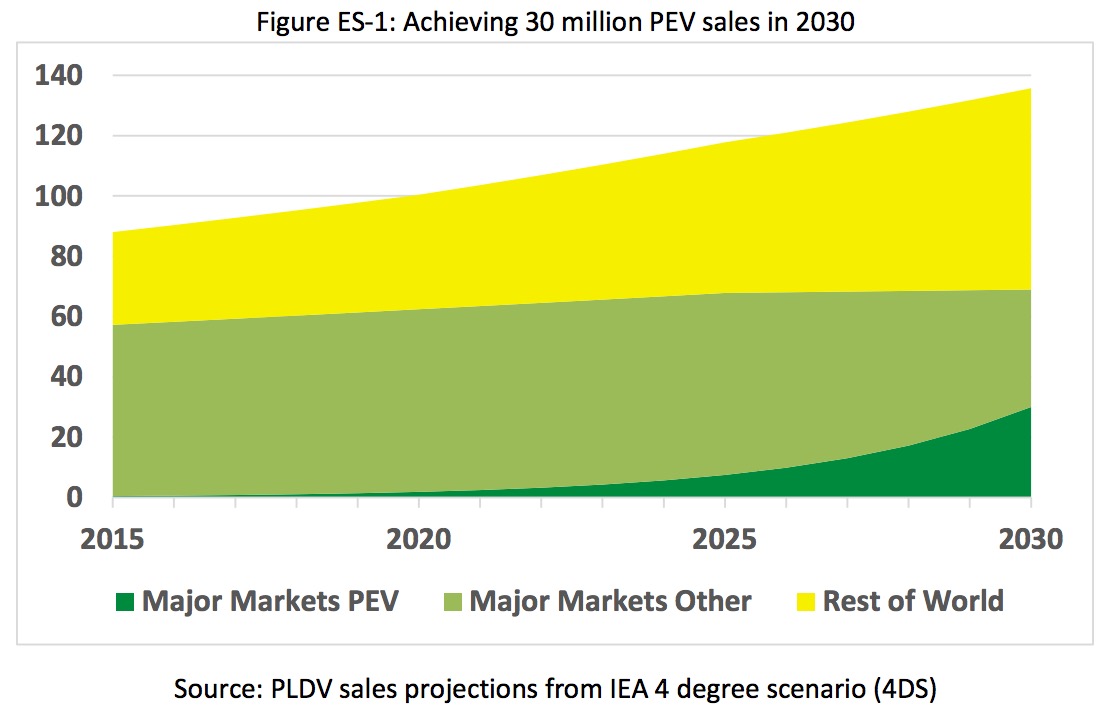GLOBAL FUEL ECONOMY INITIATIVE
UC DAVIS INSTITUTE OF TRANSPORTATION STUDIES
Executive Summary
This paper explores recent trends in the market penetration of plug-in electric vehicles (PEVs) in selected countries around the world, and the implications of this for a potential transition to a fairly dominant PEV market presence within the next 15 years. A useful context is provided by the Paris Declaration on Electro-mobility (UNFCCC, 2015), which calls for 400 million PEVs on the world’s roads by 2030, of which at least 100 million are expected to be passenger light-duty vehicles (automobiles, sport utility vehicles/SUVs, vans and passenger light trucks). Today there are about one and a quarter million PEVs (IEA, 2016), comprised of battery electric vehicles (BEVs) and plug-in hybrid electric vehicles (PHEVs), on the world’s roads with the vast majority in the United States, Europe, Japan and China. Thus the Paris Declaration represents a call for nearly a 100 fold increase in these numbers over the coming 15 year period.
This paper investigates the feasibility and extent of the challenge in achieving such a target in a number of ways:
- It reviews the status and recent trends in development and sales of PEVs across the 8 largest world markets (China, Japan, France, Germany, Netherlands, Norway, UK and US), representing the vast majority of global PEV sales to date.
- It explores the expected growth in all light-duty vehicle sales and stocks around the world, and what a 100 million target may mean in terms of a necessary international sales growth trajectory for PEVs.
- It undertakes a PEV market analysis for a few specific countries.
- It creates one plausible scenario for growth in PEV sales to meet the target, and how growth in sales per model sold can help drive the much needed growth in the number of models offered.
- It considers some of the challenges in achieving this scenario, and some initial considerations around policies needed to achieve the 100 million target.
Regarding achieving 100 million PEVs worldwide by 2030, our analysis finds:
- To reach a global stock of 100 million PEVs by 2030, sales growth will need to be very rapid and reach somewhere between 20 and 40 million per year by 2030, depending on the shape of the sales growth curve. Here we use a 30 million target which represents a slightly declining growth rate over time, consistent with a growing market, and an average growth rate of about 35% per year for 15 years.
- This target can be thought of in terms of numbers of PEV models multiplied by the average sales per model. For example, 30 million sales could be achieved with 100 models of PEV selling 300,000 units each around the world in that year, or 300 models selling 100,000 units each; either way a daunting challenge. We look at the case of 200 models with 150,000 unit sales.
- Figure ES-1 shows one potential sales trajectory to get to 30 million per year in 2030. If it occurred completely in the current “Major Markets”, it would represent nearly half of the projected 4-wheel passenger light-duty vehicles (PLDV) sales in those countries in that year. Clearly it will be easier to meet this challenge if a significant number are also sold in non-OECD countries, where nearly all overall PLDV sales growth is expected to occur.
- Although the 30 million sales target is not that large compared to the projected global PLDV sales in 2030 (about 22%), it becomes a more daunting task when considered from the point of view of the required growth rates in PEV markets around the world.
Download full version (PDF): Can We Achieve 100 Million Plug-In Cars by 2030?
About the Global Fuel Economy Initiative
www.globalfueleconomy.org
The Global Fuel Economy Initiative (GFEI) exists to assist governments and transport stakeholders promote greater fuel economy. Using the skills and expertise of the GFEI partners (The International Energy Agency (IEA), United Nations Environment Programme (UNEP), International Transport Forum of the OECD (ITF), International Council on Clean Transportation (ICCT), Institute for Transportation Studies at UC Davis, and the FIA Foundation), the GFEI Toolkit team are able to establish a baseline in each country; present policy options and case studies; and enable all stakeholders to engage in the policy process.
About the UC Davis Institute of Transportation Studies
its.ucdavis.edu
The Institute of Transportation Studies at UC Davis (ITS-Davis) is the leading university center in the world on sustainable transportation. It is home to more than 60 affiliated faculty and researchers, 120 graduate students, and a budget of $12 million. While our principal focus is research, we also emphasize education and outreach.
Tags: Electric Vehicles, EVs, GFEI, Global Fuel Economy Initiative, ITS-Davis, PEV, Plug-in Electric Vehicles, UC Davis Institute of Transportation Studies







 RSS Feed
RSS Feed
There already is a car that gets better than 100 mpgE called the TriTrack. To achieve high mileage at high speed it requires that the car body have a much lower Cd (aerodynamic drag coefficient)AND a smaller frontal area for a four seater car. In addition to lower air drag which is the majority component lower rolling friction is required and that shifts stopping to a separate path from forward traction.
There are plenty of cars today that exceed 100 mpgE. If cars are built to TriTrack advanced standards mpgE as a term completely goes away as it is powered 100% in real time with PV solar panels along the path (not on the roof of the car). That moves 100 out to infinity which makes it hard to discuss in percentage terms. Foot dragging by the big car companies only damages the world economy.
The carrot is higher speed commute with no more traffic congestion. The bonus is clean air and no more foreign oil.